Nissan Altima (L32) 2007-2012 Service Manual: Electrical leak detector
Electronic Refrigerant Leak Detector
PRECAUTIONS FOR HANDLING THE LEAK DETECTOR
When performing a refrigerant leak check, use a electronic refrigerant leak detector (J-41995) or equivalent. Ensure that the instrument is calibrated and set properly per the manufacturer's operating instructions.
The leak detector is a delicate device. In order to use the leak detector properly, read the manufacturer's operating instructions and perform any specified maintenance.
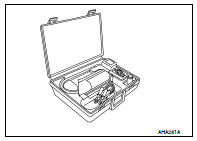
1. Position the leak detector probe approximately 5 mm (3/16 in) away from the point to be checked.
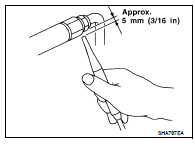
2. When testing, circle each fitting completely with the leak detector probe.
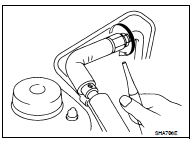
3. Move the leak detector probe along the component at approximately 25 to 50 mm (1 to 2 in)/sec.
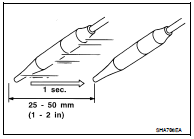
CHECKING PROCEDURE
NOTE: To prevent inaccurate or false readings, make sure there is no refrigerant vapor, shop chemicals, or cigarette smoke in the vicinity of the vehicle. Perform the leak test in a calm area (low air/wind movement) so that the leaking refrigerant is not dispersed.
1. Turn engine OFF.
2. Connect a suitable A/C manifold gauge set to the A/C service ports.
3. Check if the A/C refrigerant pressure is at least 345 kPa (3.52 kg/cm2, 50 psi) above 16°C (61°F). If less than specification, recover/evacuate and recharge the system with the specified amount of refrigerant.
NOTE: At temperatures below 16°C (61°F), leaks may not be detected since the system may not reach 345 kPa (3.52 kg/cm2, 50 psi) pressure.
4. Conduct the leak test from the high side (compressor discharge to evaporator inlet) to the low side (evaporator drain hose to the compressor shaft seal). Refer to HA-31, "Component". Clean the component to be checked and move the leak detector probe completely around the connection/component.
Perform a leak check for the following areas: • Compressor
• High and low-pressure hose fittings, relief valve and shaft seal.
• Liquid tank
• Refrigerant pressure sensor
• Service valves
- Check that all the service valve caps are secure on the service valves (to prevent leaks).
- After removing A/C manifold gauge set from service valves, wipe any residue from the valves to prevent any false readings by the leak detector.
• Evaporator
- With engine OFF, turn blower fan on high speed for at least 15 seconds to dissipate any refrigerant trace around the evaporator. Wait a minimum of 10 minutes accumulation time (refer to the manufacturer's recommended procedure for actual wait time) before inserting the leak detector probe into the drain hose.
- Keep the probe inserted for at least 10 seconds. Use caution not to contaminate the probe tip with water or dirt that may be in the drain hose.
5. If a leak detector detects a leak, verify at least once by blowing compressed air into area of suspected leak, then repeat check as outlined above.
6. Do not stop when one leak is found. Continue to check for additional leaks at all system components.
If no leaks are found, perform steps 7 - 10.
7. Start engine.
8. Set the front air control as follows; a. A/C switch: ON
b. Mode: Vent
c. Intake position: Recirculation
d. Temperature: MAX cold
e. Blower fan speed: High
9. Run engine at 1,500 rpm for at least 2 minutes.
10. Turn engine off and perform leak check again following steps 4 through 6 above.
Refrigerant leaks should be checked immediately after stopping the engine. Begin with the leak detector at the compressor. The pressure on the high pressure side will gradually drop after refrigerant circulation stops and pressure on the low pressure side will gradually rise, as shown in the graph. Some leaks are more easily detected when pressure is high.
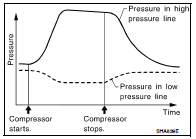
11. Before connecting the recovery/recycling equipment to the A/C system, check the recovery/recycling equipment gauges. No refrigerant pressure should be displayed. If pressure is displayed, recover the refrigerant from the equipment lines and then check the refrigerant purity.
12. Confirm the refrigerant purity in the supply tank using the recovery/recycling equipment and the refrigerant identifier equipment.
13. Confirm the refrigerant purity in the A/C system using the recovery/recycling equipment and the refrigerant identifier equipment.
14. Discharge the A/C system using approved refrigerant recovery/recycling equipment. Repair the leaking fitting or component as necessary.
15. Evacuate and recharge the A/C system and perform the leak test to confirm there are no refrigerant leaks.
16. Conduct the A/C performance test to ensure that the system works properly. Refer to HAC-5, "Operational Check".

 Fluorescent leak detector
Fluorescent leak detector On-vehicle repair
On-vehicle repair